Note: This publication is currently undergoing major revisions. The current publication will be replaced with a new publication based on stakeholder requirements and scientific advances. We expect to begin sharing details on this soon. If you have input on content, format, or publication frequency at any time, please contact us at cbrfc.webmasters@noaa.gov.Upper Colorado Water Supply Outlook, June 1, 2011Upper Colorado Water Supply Outlook, June 1, 2011
Contents
Upper Colorado Summary
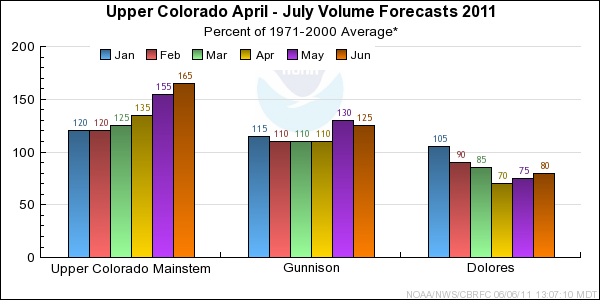
*Median of forecasts within each basin.
Upper Colorado Mainstem Basin Conditions
Most of these forecast volumes are in the top two historical
volumes of the last 40 years for both the April-July and the June-July period.
The following points are forecast at or above the record volume:
Lake Granby, Willow Creek Reservoir, Wolford Reservoir,
Colorado River near Kremmling, and Colorado River near Dotsero
The following conditions influenced this month's forecasts:
Precipitation:
May
precipitation was near 130 percent of
average overall in the Upper Colorado mainstem basin making it above average
for seven out of the eight months of this water year so far.
Seasonal
precipitation (the total since October) remained
at 140 percent of average.
Snow:
June 1st snow water equivalent was near 290 percent of average in the basin
as a whole; please note that this time of year the percent of average may not provide
a valid measure of conditions.
Another month of cooler than average temperatures has delayed the
bulk of the snow melt and as of June 1st there was still 100% of the average
seasonal peak, which usually occurs in mid April.
Conditions are even more extreme in the headwaters of the basin where the
June 1st snow water equivalent was near 130 percent of the average seasonal peak.
Many snotel sites throughout the basin have snow water equivalent values that
are at record levels when compared to their historical period (20-30 years).
--- Upper Colorado basin
snow
water equivalent plot
Streamflow:
April streamflow was above average at 110 percent.
Soil Moisture:
Modeled
soil
moisture states were near to above average heading into the winter.
Climate Forecasts:
Climate forecasts were not a factor because there is not a strong correlation
between La Nina conditions and winter precipitation in the Upper Colorado mainstem basin.
Forecast Summary:
Most forecast volumes were raised from last month due to the
much above average precipitation during May as well as cool temperatures which
inhibited the snow melt. This has resulted in near to above record snow pack
conditions throughout much of the basin. Current April through July streamflow volume
forecasts range between 140 and 235 percent of average with a median
value of 165 percent. Current June through July streamflow volume forecasts range
between 165 and 315 percent of average with a median value of 190 percent.
Most of these forecast volumes are in the top two historical
volumes of the last 40 years for both the April-July and the June-July period.
The following points are forecast at or above the record volume:
Lake Granby, Willow Creek Reservoir, Wolford Reservoir,
Colorado River near Kremmling, and Colorado River near Dotsero

* Percent usable capacity, not percent average contents.
Click for multi-month Graph.
Gunnison Basin Conditions
The following conditions influenced this month's forecasts:
Precipitation:
Seasonal October through May
precipitation was 120 percent of average
in the Gunnison basin. May
precipitation was 115 percent of average.
Snow:
June 1st snow water equivalent was near 230 percent of average in the Gunnison basin; please note that this time of year the percent of average may not provide
a valid measure of conditions.
--- Gunnison basin
snow
water equivalent plot
Streamflow:
May streamflow was 90 percent of average.
Soil Moisture:
Modeled
soil
moisture states were below to near average heading into the winter.
Climate Forecasts:
Climate forecasts were not a factor because there is not a strong correlation
between La Nina conditions and winter precipitation in the Gunnison basin.
Forecast Summary:
May precipitation throughout the Gunnison basin was above average at 115%. Seasonal precipitation for the Gunnison did not change from last month's 120% of
average. The current April through July streamflow volume forecasts dropped 5% from last month's forecast. Current April through July streamflow volume
forecasts range
between 100 and 133 percent of average with a median value of 125 percent.
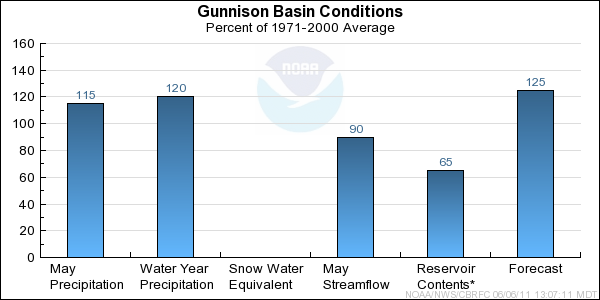
* Percent usable capacity, not percent average contents.
Click for multi-month Graph.
Dolores Basin Conditions
The following conditions influenced this month's forecasts:
Precipitation:
Seasonal October through May
precipitation was 105 percent of average
in the entire Dolores basin. May
precipitation was 150 percent of average.
Snow:
June 1st snow water equivalent was 140 percent of average in the Dolores basin; please note that this time of year the percent of average may not provide
a valid measure of conditions.
--- Dolores basin
snow
water equivalent plot
Streamflow:
May streamflow was 70 percent of average.
Soil Moisture:
Modeled
soil
moisture states were average to slightly below average heading into the winter.
Climate Forecasts:
The correlation of La Nina and April through July water volumes in the Dolores basin is small that
it did not influence the forecast process.
Forecast Summary:
May precipitation throughout the Dolores basin was much above average at 150%. Seasonal precipitation for the Dolores basin remained the same from
last month at 105% of average. Due to the cool temperatures in May and above average monthly precipitation, this month's April-July forecast volumes rose
slightly from last month. Current April through July streamflow volume
forecasts range between
76 and 93 percent of average, with a median value of 80 percent.
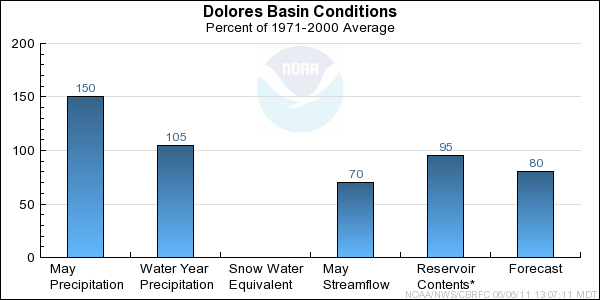
* Percent usable capacity, not percent average contents.
Click for multi-month Graph.
Differences between the full period forecasts and the residual forecasts may not exactly equal the actual observed volumes due to rounding conventions (see Definitions section).
Reservoir Monthly Inflow Forecasts
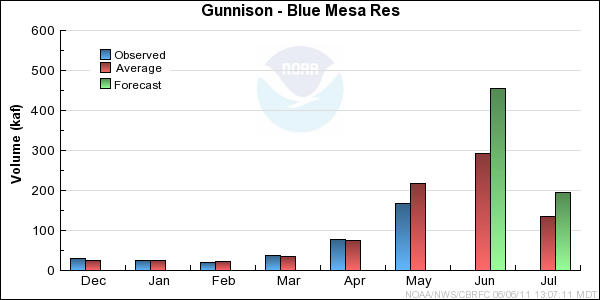

Monthly Streamflows

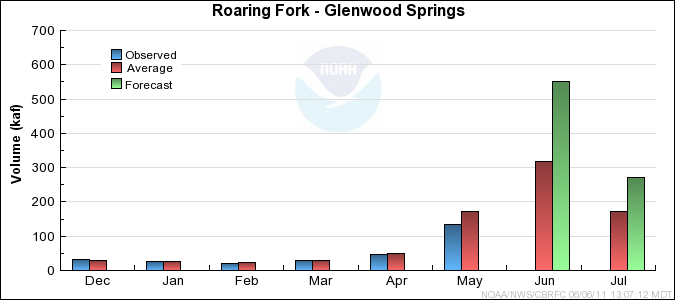
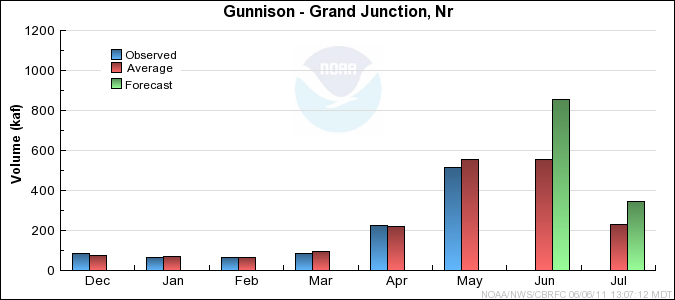
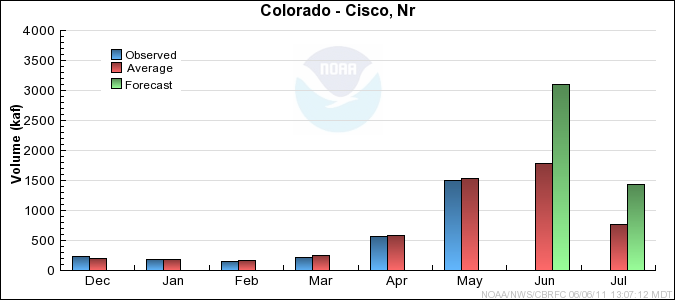
Precipitation Maps
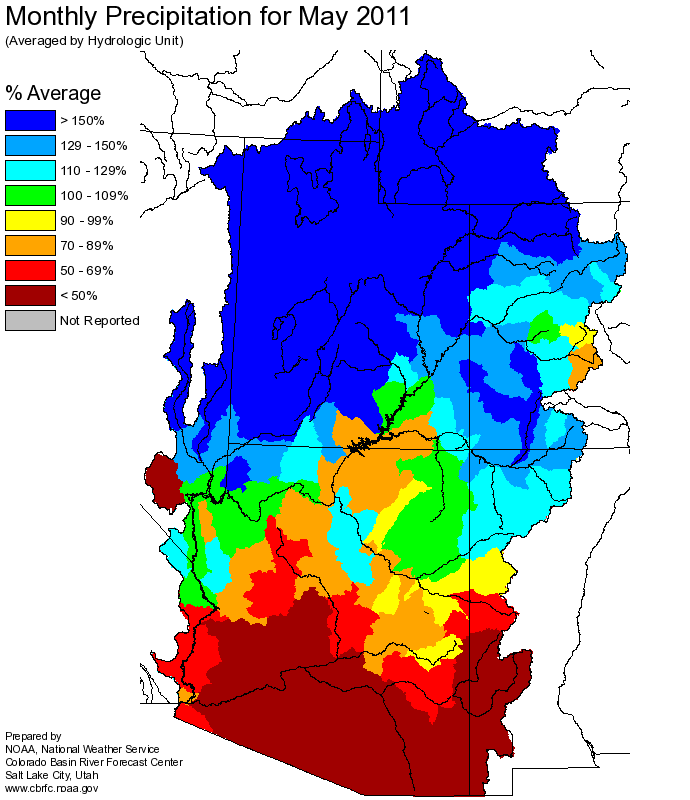
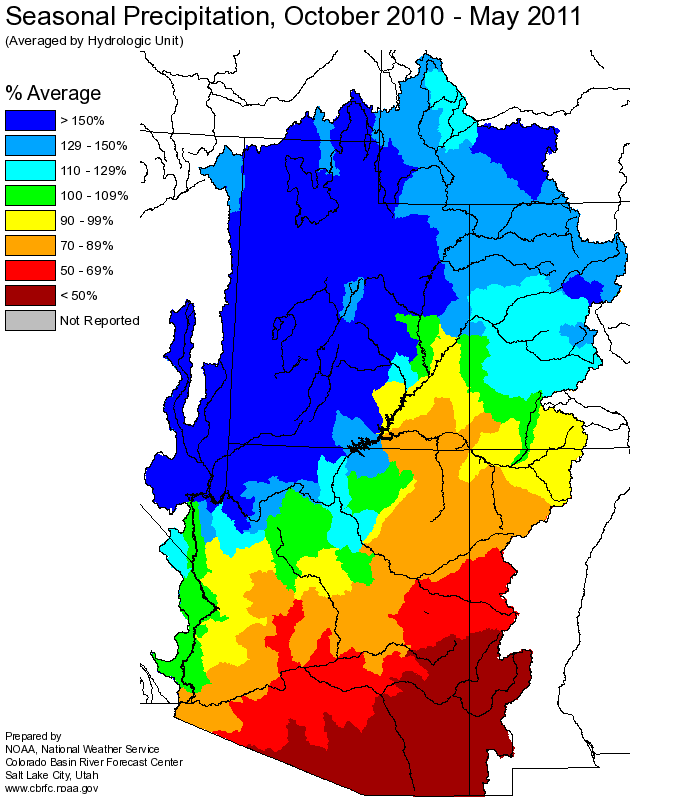
Hydrologist: Brenda Alcorn, Tracy Cox













